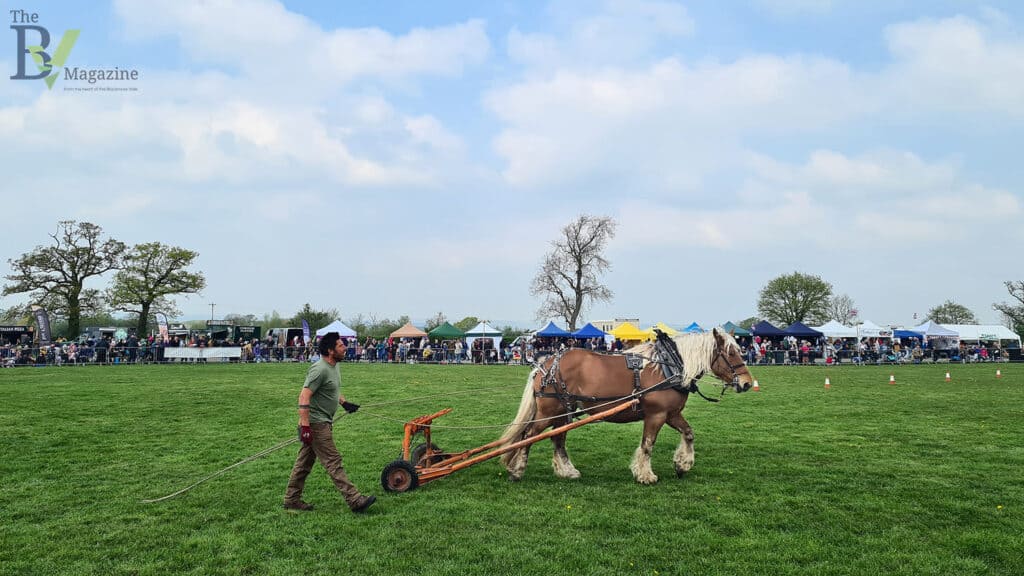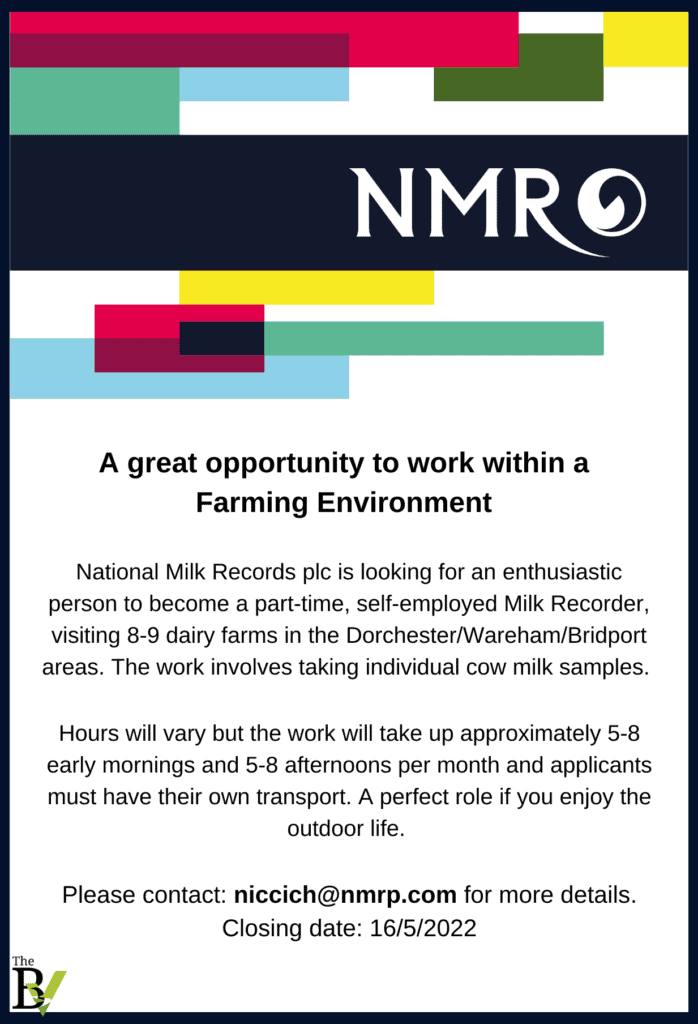Hilda Hovell, formerly of Gillingham, passed away peacefully in Bodmin, Cornwall aged 92 years.
Much loved mum of Philip, Johnathon and Alison and a dear grandma and great grandma.
Any enquiries please to Bodmin Funeral Services 01208 78300.
Richard Hunt is looking to employ a person at Templecombe to work with an experienced team.
Hedge cutting, field tractor work as well as muck spreading and young stock and relief milking.
Please Contact Mike on: 07720 871629
or email [email protected]
With few crops left in the ground to harvest and the start of planting/sowing for the coming season, March is the beginning of the new allotment year. We are picking plentiful spears of both early and late purple sprouting broccoli (Rudolph and Claret). Claret started to produce earlier than normal, brought on by the days of glorious sunshine which started on the 17th.
We cut our first Medallion cauliflower mid-month (top picture); not as large as the winter cropping Cendis which we grow, but still of a good size. We grow this variety because it always crops earlier than other spring varieties, and we need to clear the ground for the next crop which will be potatoes. We have a six year rotation of all our crops, except potatoes which are three years.
Throughout the month we also harvested parsnips and leeks. With a good supply of both we were able
to give some to other allotmenteers.
At home we cut our second lot of chicons on the 25th, hopefully we will get a third cut in about
three weeks time.
By the time you read this we will have planted seven lines of potatoes – Foremost, Charlotte, Elfe,
International Kidney, McCain Royal and Rooster. Further lines of Rooster and Picasso will be planted
in April.
By the 25th the soil temperature was warm enough to sow part lines of carrot and beetroot.
In the greenhouse we have plug trays of onions, cabbages and lettuce, and these will be ready to
plant out in April. During the sunny days we have enjoyed seeing Commas, Small Tortoiseshells, Brimstones and Orange Tips flying over the plots.
Despite two days with heavy rainfall (over an inch on the 11th with a further 0.8 inches on the 16th) our soil dug well after about six days. We only dig about one third of our total plot area each year to fit in with the rotation. I love digging, and it never seems like hard work with a good long handled spade.
During the last 34 years on our plot at Sturminster I have made some interesting finds while turning over the soil:
• An Elizabeth 1st silver sixpence.
• 1790 George third gaming token.
• Prince of Wales half sovereign (Date ?)
• 17th century wine bottle seal, showing what I think is a mermaid
• A yellow submarine – A baking powder ‘Atomic Sub’ from a 1957 packet of Kellogs Cornflakes!
by Barry Cuff
Sponsored by – Thorngrove Garden Centre
Wells, Bath & Sherborne Office – Full Time
We want every client that chooses to work with us to have a great experience and that is why we have created this new role. The purpose of this role is to work with both our clients and legal teams to champion client experience at all times.
The role will require you to work at pace within agreed service level agreements while ensuring all regulations are adhered to. You will be flexible in your approach, pro-active and solution focused in order to make working with us easy from our clients point of view while providing exceptional administration support to our legal teams. You will be privy to some confidential information so your ability to maintain client confidentiality is most important.
We are currently looking for three new Central Operations Assistants one for Bath, Wells and Sherborne.
For more details and full job description, please see the Mogers Drewett website here – www.mogersdrewett.com/careers-2/
Send your CV to [email protected]

An equinox and a solstice occur twice each year; once in the spring/summer and once in the autumn/winter.
The equinoxes sit between the two solstices (the longest and shortest days) and mark the point where the sun crosses the earth’s celestial equator and becomes equally positioned between the northern and southern hemispheres.
The spring equinox, which began on 20th March, signifies the point where days become longer than the nights.
We all know that long dark nights paired with low temperatures and unsurprising downpours can take a toll on our mood and make us feel sluggish. With daylight hours increasing and the sun sitting higher in the sky
we now have the opportunity and the time to not only give our homes a much-needed spring clean but also consider whether our minds and bodies need a spring refresh as well.
5 Ways to Wellbeing
The 5 Ways to Wellbeing is a proven group of steps that we can use to check and identify the ‘dust’ we collect as a result of Winter’s stressors. They provide ideas about what we can do to help manage our
wellbeing:
1. Take Notice
The first step encourages us to pay attention to what is going in our environment. In the context of spring this may be done by taking a walk and noticing the new life rising – new plant growth or a rise in temperature.
2. Get Active
Taking notice leads nicely into the next stage – and ‘getting active’ isn’t as scary as it sounds. Think low impact, high reward. Walking for example, is a free, easy way to get active – never dismiss the power of a simple walk. Walking helps to build stamina and improve heart health and with warmer climes on their way,
a walk in the sunshine is a sure-fire way to blow away cobwebs.
3. Learning
With spring comes change, and learning something new is the third stage of the ‘5 Ways’, can help us to stay spry and build new neural pathways. So why not pick up a new hobby or learn something new?
4. Give Back
Speaking of which, the fourth stage of the checklist is ‘give back’ – why not make your new hobby/activity a fundraising activity for a charity or volunteering? I know that when we feel overwhelmed with life it may feel
like we have nothing more to offer people. However, when we ‘give back’ we ‘get back’ in return not only in the form of validation that we are doing something good but also that it is making a difference.
5. Connect
The final stage motivates us to work on our connections with our loved ones and our social groups, but also to connect with our own body and our mind too. This stage might be considered the most important; without connection to our body and mind the other four stages become difficult to implement.
Without connection to our minds we cannot ‘take notice’ of what is weighing on us or ‘learn’ something new, and without connection to our body we cannot know how best to nourish it.
Further Help and Support Find out more about the 5 ways to look after your mind and body here:
https://bit.ly/5WaystoWellbeing
Soil your pants? Ew! I hear you all cry. Disgusting!
What on earth is she on about now?
Allow me to explain… The latest science emphasis in growing flowers or vegetables is all about your soil’s health (is this something else we have to worry about now?).
On digging a bit deeper (excuse the pun) it does seem to make some sense. If your soil is super healthy and full of all the micro-organisms it needs, then your plants too will thrive and flourish as they take up all those lovely nutrients from that super healthy soil. But we need to understand more.
An unorthodox test lab
The conventional way to test your soil is to spend money on a specialist kit, send away the samples to be tested in a laboratory and then receive the results back – and not really understand what they are, or be any clearer on the findings (is a low Ph level good or bad? I barely knew what that meant at school …).
The unconventional way, and the one I have read up on, is far simpler. You need to ‘plant’ a pair of 100% cotton Y fronts or boxers (best to ask the owners permission before taking them – you don’t want to be burying his lucky pants) in the soil in your garden.
Bury the pants, several pairs if your garden is extensive, roughly 10 to 15cm deep in your flower or vegetable beds, and simply leave them for six weeks. Mark where you planted them (or some time in the future you will have men in white all-in- one suits looking for where the body is buried) and make a note in your diary of when to dig them up. After your six weeks are up, if the pants are still wearable and will protect your modesty then your soil needs attention. If they are ragged and rotting then you’ve lost a pair of pants, but can rest assured that at least your soil is alive and well. You should have good healthy flowers and vegetables. And probably buy some new pants.
Apparently the optimum season to try this experiment is in the summer months when the soil’s biology is more active.
What to do next
If your experiment reveals less than healthy soil, there are a few things that you can do. Firstly stop using pesticides and chemicals; their effects underground might not be obvious at first, but in time they might be having the opposite effect to the one intended and be destroying your garden.
Secondly, minimise digging so as to avoid disturbing the complex structure of the soil – farmers have almost entirely stopped ploughing their fields for this same reason.
Of course, do add peat-free – or better still your own – garden compost and other well rotted organic matter on the top, and just let the worms bring this down into the soil.
I will report back on the result of my test and share the results (but not the pictures!).
by Charlotte Tombs
With Easter approaching, it might seem like a great time to buy an ‘Easter Bunny’. While rabbits make lovely pets it is always important to do your research before getting a new animal to care for.
Your main considerations when deciding whether to take on a pet rabbit should be whether you can provide enough space and suitable housing, the right kind of company (rabbits are very social animals and should be kept in pairs or small groups), the correct diet and suitable healthcare. It is always an exciting time to get a new pet, but it is important that you can commit to being able to care for them lifelong; the current estimate from the PDSA on the cost of owning a rabbit ranges from £6,500 up to as much as £30,000 for their lifetime – and they can live up to 10 years.
Choosing the right bunny for you should be well thought through, and ideally we would always recommend rehoming from a reputable rescue centre, such as Margaret Green Animal Rescue based in Church Knowle in Dorset. If you are thinking about getting a rabbit, check out the PDSA website for more information on caring for them and recommended suitable housing.
Chocolate
During Easter the amount of chocolate in your home will most likely be on the rise. This is great for you – but not so great for your dogs.
Chocolate contains an ingredient called theobromine; this is hard for dogs to digest, allowing it to build up to
toxic levels in their system very quickly. Different chocolate has different levels of theobromine:
Cocoa, cooking chocolate and dark chocolate have the highest levels of theobromine, whereas white and milk chocolate have the lowest. This is why it is very important to know what type of chocolate your pet has eaten so the vet can assess the toxicity correctly.
The amount that is fatal to your pet depends on its size. For example a St Bernard could eat more chocolate
than a Chihuahua before it would become ill, whereas the Chihuahua wouldn’t need much at all to make it poorly. In large doses chocolate can be fatal to dogs – it can cause seizures, irregular heartbeat, internal bleeding and heart attacks.
To try and reduce the risk of your pet getting hold of any chocolate try and keep any chocolate out of reach of your dog, securely stored away from them and sealed. If your pet has ingested chocolate we advise you
call your vet immediately. The usual protocol is to induce vomiting within two hours of the consumption to
ensure there is no chocolate left in the dog’s system.
By Damory Veterinary Clinic
What a great day we had at the Spring Countryside Show today – are you going tomorrow? There’s so much to see, but here’s our own highlights:

![]() The Sheep Show. Brilliantly entertaining whilst being oddly educational – seriously do NOT miss this show. Way more fun than one man and his sheep has any right to be.
The Sheep Show. Brilliantly entertaining whilst being oddly educational – seriously do NOT miss this show. Way more fun than one man and his sheep has any right to be.
You can find it in the Friars Moor Farm Yard, three shows through the day

![]() The Farrier. For those of us not fortunate enough to have a horse, the Spring Countryside Show is a fascinating chance to see the farrier skills up close, and Sam is great at explaining as he goes.
The Farrier. For those of us not fortunate enough to have a horse, the Spring Countryside Show is a fascinating chance to see the farrier skills up close, and Sam is great at explaining as he goes.
Find him in the Garden Village, three demos through the day

![]() The Falconry display. I never miss the opportunity to watch Mere Down Falconry, it’s always a brilliant show. Made even more entertaining today by an unrepentantly bolshy falcon refusing to come home – he simply buzzed the crowd with flashy fly-bys, showing off his skills.
The Falconry display. I never miss the opportunity to watch Mere Down Falconry, it’s always a brilliant show. Made even more entertaining today by an unrepentantly bolshy falcon refusing to come home – he simply buzzed the crowd with flashy fly-bys, showing off his skills.
See this in the Gritchie Brewing Company Rural Ring, two shows
![]() Heavy Horse Logging – it’s amazing watching the team at work, and incredibly interesting to learn about an ancient industry that still has a place in modern forestry. Definitely worth stopping to watch it.
Heavy Horse Logging – it’s amazing watching the team at work, and incredibly interesting to learn about an ancient industry that still has a place in modern forestry. Definitely worth stopping to watch it.
See it in the Gritchie Brewing Company Rural Ring, two shows

![]() Jonathan Marshall’s Free Spirits Show at Dorset’s Spring Countryside Show – no one could walk past without stopping to watch the beauty of Jonathan’s Amadeus (yes, he’s one of the Lloyds Bank black horse) and Aria the falcon. Not the show you’re expecting – see our interview with Jonathan Marshall here.
Jonathan Marshall’s Free Spirits Show at Dorset’s Spring Countryside Show – no one could walk past without stopping to watch the beauty of Jonathan’s Amadeus (yes, he’s one of the Lloyds Bank black horse) and Aria the falcon. Not the show you’re expecting – see our interview with Jonathan Marshall here.
See Jonathan in the Gritchie Brewing Company Rural Ring, two shows

![]() Terrier Racing – Hilarious! Think your dog has the speed? Enter them in the terrier racing (not just for terriers, we saw all sorts having a go) – it was just beautifully brilliant chaos. And the commentator is ace. Don’t miss it!
Terrier Racing – Hilarious! Think your dog has the speed? Enter them in the terrier racing (not just for terriers, we saw all sorts having a go) – it was just beautifully brilliant chaos. And the commentator is ace. Don’t miss it!
In the Gritchie Brewing Company Rural Ring, two shows a day.
![]() ALL THE FOODS! Seriously. Cheese, gin, great burgers, hog roast, jams, chills, pancakes, doughnuts, sausage rolls, cakes, fudge… Go prepared.
ALL THE FOODS! Seriously. Cheese, gin, great burgers, hog roast, jams, chills, pancakes, doughnuts, sausage rolls, cakes, fudge… Go prepared.
















A great opportunity to work within a Farming Environment
National Milk Records plc is looking for an enthusiastic person to become a part-time, self-employed Milk Recorder, visiting 8-9 dairy farms in the Dorchester/Wareham/Bridport areas. The work involves taking individual cow milk samples.
Hours will vary but the work will take up approximately 5-8 early mornings and 5-8 afternoons per month and applicants must have their own transport. A perfect role if you enjoy the outdoor life.
Please contact: [email protected] for more details.
Closing date: 16/5/2022
